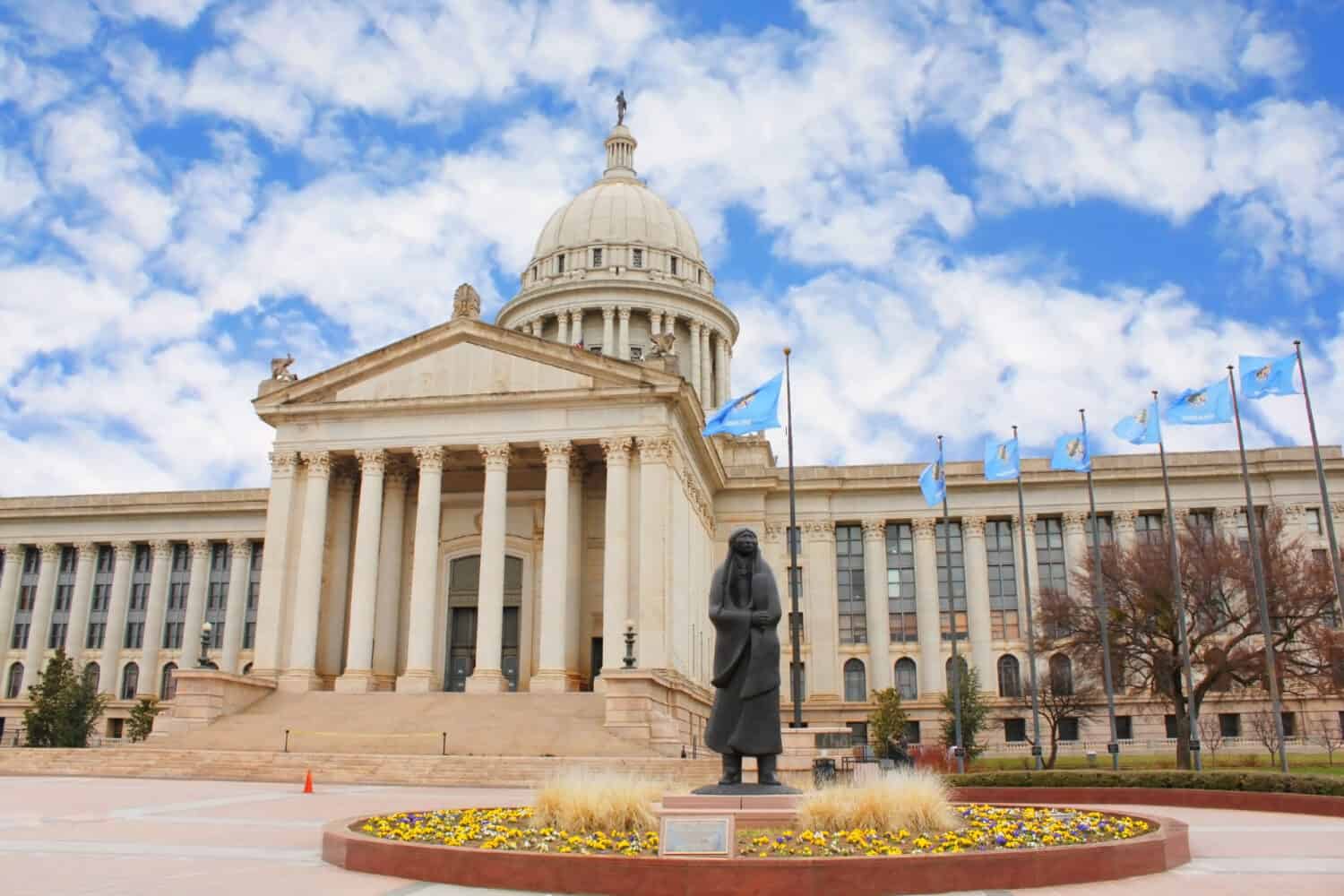When we think about clean towns, we often imagine trash-free streets, immaculate parks, and crystal-clear streams and lakes. An often-forgotten element of cleanliness, air quality, also factors into what makes a city clean. While many towns enjoy clean, breathable air, other towns are not so fortunate.
Overall, Oklahoma enjoys relatively clean air thanks to its wide-open spaces and low population. However, a few cities in the state experience higher levels of air population than others. Keep reading to discover the Oklahoma town with the state’s worst air quality. We’ll also discuss the history of the town, its air quality index score, and what wildlife you can find in the area.
History of Oklahoma City, OK

Oklahoma City is the capital of Oklahoma and the state’s largest city.
©val lawless/Shutterstock.com
Also known as OKC, Oklahoma City is the capital and largest city in Oklahoma. The modern-day city dates back to the Oklahoma Land Rush of 1889. On April 22, 1899, approximately 10,000 homesteaders flooded into the former Indian Territory and settled in the area where Oklahoma City now stands. The city’s population grew quickly and soon became the state’s commercial and political hub.
The development of major stockyards further contributed to Oklahoma City’s growth in the early 20th century. This growth was bolstered by the discovery of oil within the city’s limits in 1928. At its peak, the city operated around 1,400 oil wells, although only a few hundred remain in operation to this day. The city’s central location also contributed to its prominence as a transportation hub and helped to solidify its economic growth and presence.
Today, Oklahoma City has a highly diversified and modern economy. Major products that it produces include industrial machinery, petroleum products, and automotive parts. It continues to function as a distribution center for crops and animal products as well as services such as tourism, healthcare, and education. The city also ranks as one of the main aviation hubs in the country thanks to the presence of Tinker Air Force Base and the FAA’s Mike Monroney Aeronautical Center.
Oklahoma City Population and Size
As of the 2020 census, approximately 681,054 people live in Oklahoma City. That said, the Oklahoma City metropolitan area contains a total of 1,396,445 people. The metropolitan area includes Oklahoma City proper as well as surrounding cities Norman and Edmond. Other communities in the metro include suburbs such as Bethany, Del City, Midwest City, Moore, and Yukon.
Oklahoma City encompasses a total area of 620.34 square miles. It has a population density of around 956.4 people per square mile.
Air Quality Index
The Environmental Protection Agency uses an index to measure and report air quality in the United States. This Air Quality Index (AQI) tracks 6 major pollutants in the air that all fall under the regulations of the Clean Air Act. By tracking these pollutants, the EPA can determine a city or region’s air quality. These pollutants include:
- Ozone (O3)
- Carbon monoxide (CO)
- Nitrogen dioxide (NO2)
- Particulate matter (PM10 and PM2.5)
- Lead (Pb)
- Sulfur dioxide (SO2)
Based on the presence of these pollutants, the AQI scores areas on a scale of 0 to 500. A score of 0 represents perfect air, while a score of 500 equals the dirtiest air imaginable. For reference, a score of 300 or more represents air quality hazardous to human health. Meanwhile, anything under 100 represents a tolerable or national standard for air quality for a given pollutant. In many cases, the AQI also associates certain scores with colors.
Here is a graphical representation of the AQI and what each score and color means:
| AQI Score | Score Description | Color |
|---|---|---|
| 0-50 | “Good.” Satisfactory air quality with little to no pollution. | Green |
| 51-100 | “Moderate.” Acceptable air quality with some pollutants present that pose a moderate health concern to a small number of people. | Yellow |
| 101-150 | “Unhealthy for Sensitive Groups.” While safe for the general public, air quality in this range poses a greater risk to sensitive groups, such as the very old, young children, and people with lung and heart disease. | Orange |
| 151-200 | “Unhealthy.” Everyone will experience adverse health effects when exposed to air quality in this range. | Red |
| 201-300 | “Very Unhealthy.” Air quality in this range can pose serious health effects. | Purple |
| 301-500 | “Hazardous.” Air quality in this range would trigger an emergency warning and pose a danger to human life. | Maroon |
Oklahoma City’s Air Quality Index Score

Air quality index measurement
©DG-Studio/Shutterstock.com
Air Quality Index scores change from day to day and from year to year. Oklahoma’s average AQI for the year is around 43. Overall, this means Oklahoma enjoys relatively “good” air year-round. That said, the city’s total score doesn’t paint the full picture.
The levels of ozone and particulate pollution present in Oklahoma City can pose a risk to at-risk groups such as children, older adults, pregnant people, and people with chronic diseases. In fact, Oklahoma City ranked as the 48th most polluted city for ozone pollution in 2022, according to the American Lung Association. Additionally, the city ranked 63rd worst in terms of short-term particle pollution and 29th most polluted for year-round particle pollution.
What Contributes to Oklahoma City’s Poor Air Quality?
Several factors contribute to air pollution in Oklahoma City. Chemical manufacturing and power-generating companies (including oil fields) both produce pollutants that affect Oklahoma City’s air quality. That said, the number one polluter of air in the city comes from vehicle emissions. Vehicle emissions produce carbon monoxide, a known greenhouse gas. Typically, Oklahoma City’s air quality suffers most in summer when most vehicles are on the road, and temperatures rise. An excess of greenhouse gas in the atmosphere also contributes to ozone pollution, thereby exacerbating pollution in the area.
Wildlife Around Oklahoma City

Prairie dogs are a common sight around Oklahoma City.
©AB Photographie/Shutterstock.com
Although Oklahoma City is highly industrialized, you can still encounter a wide variety of wildlife in and around the city. Commonly spotted critters include raccoons, armadillos, skunks, bats, and prairie dogs. The city also houses several types of snakes, just a few of the 47 species found across the state. While you’re unlikely to encounter a venomous rattlesnake in Oklahoma City, you should still watch where you step when in areas of thick cover that snakes often frequent.
Where is Oklahoma City, OK Located on a Map?
Oklahoma City, the capital of Oklahoma, stands out for its rich cowboy/western culture and impressive capitol complex, set amidst a backdrop of active oil wells. The Oklahoma City National Memorial is a heartfelt tribute to the victims of the devastating 1995 bombing of the Alfred P. Murrah Federal Building.
Here is Oklahoma City, OK on a map:
The photo featured at the top of this post is © Gerson Repreza/Shutterstock.com
Thank you for reading! Have some feedback for us? Contact the AZ Animals editorial team.






